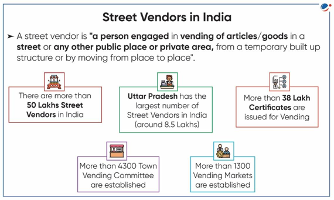Why in the news?
Recently, the Minister of Housing and Urban Affairs highlighted the slow pace of implementation of the provisions of the Street Vendors (Protection of Livelihood and Regulation of Street Vending) Act, 2014.
More about the news
- A revamped PAiSA Portal Dashboard and the PM SVANidhi Mission Monitoring Portal were also launched at the event.
- Portal for Affordable credit and Interest Subvention Access (PAiSA) is a portal designed to provide a centralized platform for Processing of Interest Subsidy to eligible beneficiaries under PM Svanidihi, Self-Employment Program etc.
Key features of the Street Vendors Act, 2014
- Rights of street vendors: Every street vendor shall have the right to carry on the business of street vending activities as per the terms and conditions mentioned in the certificate of vending.
- Duties of Street Vendors:
- Remove his goods and wares every day at the end of the time-sharing period allowed to him.
- Maintain cleanliness and public hygiene in vending zones and adjoining areas.
- Maintain civic amenities and public property in the vending zone in good condition.
- Payment of maintenance charges for the civic amenities and facilities as determined by local authorities.
- Town Vending Committees (TVCs): They are to be established in each Local Authority. These committees are in charge of enumerating, identifying, and allocating vending zones in a city.
- TVCs are to be heterogeneously constituted with at least 40% of its elected members being street vendors, of which one-third are to be women.
- Survey of the Street Vendors: At least once every five years for the issuance of a Certificate of Vending (CoV) to the vendors identified.
- Ceiling limit on the number of vendors: It is set at 2.5% of the population of the ward or zone or town or city for accommodating the vendors in the respective vending zones.
- Grievance redressal Committees: They are to be set up by the States under the chairmanship of a retired judicial officer to maintain impartiality towards grievances of street vendors.
- Period for the release of seized goods: For non-perishable goods, the goods are to be released within two working days and in the case of perishable goods, the goods shall be released the same day of claim.

Challenges associated with the functioning of the act
- Lopsided implementation: Despite a decade since enactment only 17 States have constituted Grievance redressal Committees for the welfare of the street vendors.
- The TVCs are yet to be formed in many Urban local bodies and existing TVCs also lack proper representation in many states.
- Ceiling on Number of Vendors: The act has set the limit of street vendors to 2.5% of the total population of the ward/city, which is inadequate for a major metropolis like Delhi, Mumbai etc.
- Exclusion of Railways land and its premises: The act does not apply to any land, premises and trains owned and controlled by the Railways, which is a huge business area for the vendors.
- Lack of uniformity: Currently, street vending is regulated under municipal laws enacted by state legislatures and this leads to a lack of uniformity in its implementation.
- For example, Brihanmumbai Municipal Corporation issued a Certificate of Vending based on domicile certificates till 2022, despite domicile not being a criterion under the 2014 act.
Way forward
For better implementation of the Act
- Revision of the ceiling on the number of vendors: It can be increased in consonance with the nature of the city and as per the latest survey of street vendors.
- Ensuring adequate representation: Street vendors and TVCs as stakeholders while deciding any policy framework that impacts their livelihood.
- Creation of Vending Zones near Railway Stations: This will provide more opportunities for the vendors and ensure more consistent implementation of the Act.
- Integration with the Smart City mission: Including members from the Street vendor’s community in deliberations and formulation of the Smart City projects.
- Establishment of Model Vending zones as "Light House Projects" by the Ministry of Housing and Urban Affairs, to be replicated in states.
For the Welfare of Street Vendors
- Issuance of Smartcards which integrate the details of Vendor ID cards and Certificate of Vending.
- Sensitize police force and local body officials by including the Street Vendors Act in their training curriculum to avoid excessive actions over street vendors.
- Publish Street vendors charter by every TVC specifying the time within which a CoV shall be issued, renewed and other activities to be performed.



